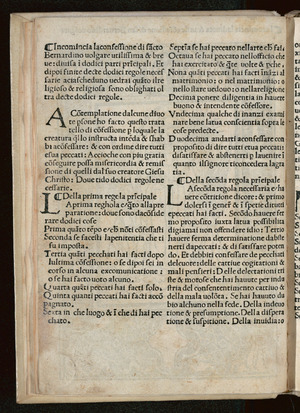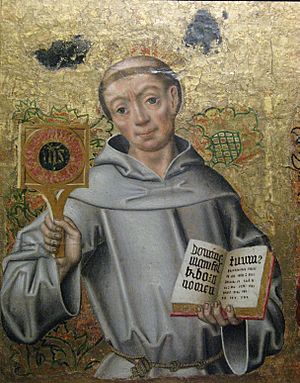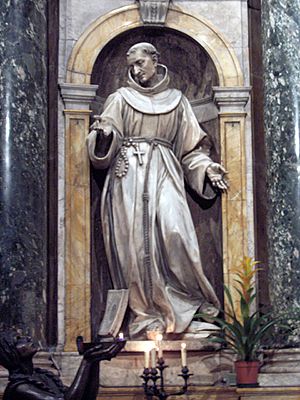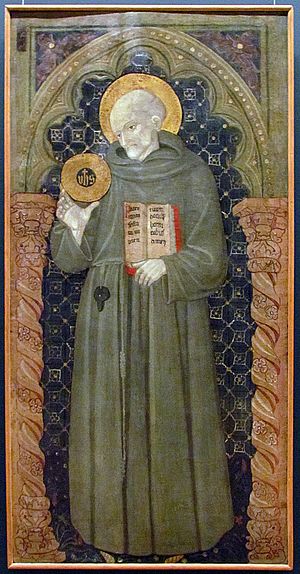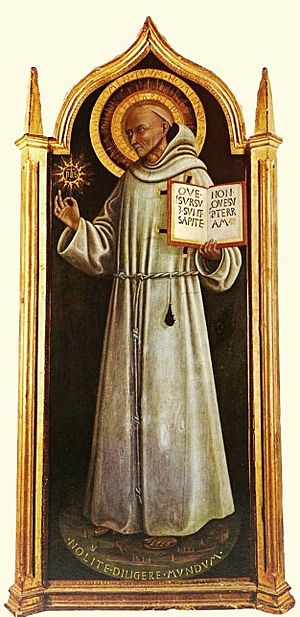Bernardino of Siena facts for kids
Quick facts for kids SaintBernardino of Siena, O.F.M. |
|
|---|---|
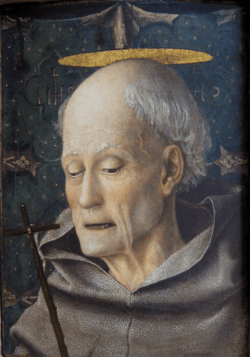 |
|
| Priest, Confessor, Apostle of Italy | |
| Born | 8 September 1380 Massa Marittima, Republic of Siena, Holy Roman Empire |
| Died | 20 May 1444 (aged 63) Aquila, Kingdom of Naples, Holy Roman Empire |
| Venerated in | Roman Catholic Church |
| Beatified | 24 November 1449 |
| Canonized | 24 May 1450, Rome, Papal States by Pope Nicholas V |
| Feast | 20 May |
| Attributes | Tablet with IHS; three mitres representing the bishoprics which he refused |
| Patronage | Advertisers; advertising; Aquila, Italy; chest problems; Italy; Diocese of San Bernardino, California; gambling addicts; public relations personnel; public relations work; Bernalda, Italy; San Bernardino, Switzerland |
Bernardino of Siena (born September 8, 1380 – died May 20, 1444) was an Italian priest and a Franciscan missionary. He was known for his powerful sermons across Italy. The Catholic Church later made him a saint, calling him "the Apostle of Italy." This was because he worked hard to help people in Italy become more religious during the 1400s.
Contents
Life of Saint Bernardino
His Early Years
Bernardino was born in 1380 in a town called Massa Marittima, in Tuscany. He belonged to a noble family. Sadly, he became an orphan at age six and was raised by his kind aunt.
In 1397, after studying law, he joined a group called the Confraternity of Our Lady. This group was connected to a hospital in Siena. Three years later, a terrible plague hit Siena. Bernardino, with ten friends, bravely took care of the sick people at the hospital for four months. He didn't get the plague himself, but he was so tired that he got a fever for several months.
In 1403, he joined the Observant branch of the Order of Friars Minor (the Franciscan Order). This group followed the rules of Saint Francis very strictly. Bernardino became a priest in 1404 and started preaching in 1405. Around 1406, another famous preacher, Vincent Ferrer, said that Bernardino would continue his work in Italy.
Bernardino as a Preacher
How He Preached
Before Bernardino, most preachers just read speeches. But Bernardino was different. He preached directly to large crowds, not just inside churches. For over 30 years, he traveled all over Italy. He helped bring back strong religious feelings in the early 1400s. Even though his voice was weak, he was known as one of the best preachers of his time.
His style was simple and easy to understand. He used everyday examples that people could relate to. His sermons were masterpieces of spoken Italian. He was very good at capturing people's attention. Towns often invited him to speak because large crowds would come to hear him. This sometimes even helped the towns make money!
Bernardino chose topics that were important to the people of Siena. He used stories from the Bible to talk about their daily lives. Most of his listeners were women. The size of the crowd changed depending on the day, time, and what he was talking about. His sermons tell us a lot about what life was like in Italy in the 15th century.
Bernardino traveled everywhere on foot. He stayed in each town for only a few weeks. Sometimes, so many people came to hear him that he had to preach from a pulpit in the marketplace. He often preached early in the morning. People would arrive very early, even from far-off villages, to get a good spot. His sermons often lasted three or four hours.
In 1424, he went to Ferrara and preached against fancy clothes and too much luxury. In Bologna, he spoke out against gambling. This made card makers and sellers unhappy. When he returned to Siena in April 1425, he preached for 50 days straight. People said his success was amazing.
He held "Bonfires of the Vanities" after his sermons. People would throw things like mirrors, high-heeled shoes, perfumes, playing cards, and dice into a fire. Bernardino told his listeners to stop swearing and gambling. He also told them to respect religious holidays.
Not everyone liked Bernardino. In L'Aquila, someone once sawed the legs of his pulpit. This caused him to fall into the crowd! In 1427, Bernardino was asked to help stop fighting between groups in Siena. He preferred preaching to solving arguments. When he spoke against fighting, he was very careful with his words. This shows that the situation could have become violent easily.
His Advice to Women
Bernardino used the Virgin Mary as a role model for women. He told girls not to talk to men unless a parent was with them. In one sermon, he warned women about marrying men who cared more about their money than about them. He also spoke against forcing girls to become nuns if they didn't want to. He held up Saint Joseph as an example for men. He also stressed that Mary was obedient to her husband.
His Trial in Rome
Bernardino was very devoted to the Holy Name of Jesus. He created a special symbol for it: "IHS." These are the first three letters of Jesus's name in Greek. He put these letters on a blazing sun. This symbol was meant to replace the symbols of fighting groups. This devotion spread, and the IHS symbol started appearing in churches and homes. Some people thought this was a dangerous new idea.
In 1426, Bernardino was called to Rome. He had to face charges of heresy (having beliefs against church teachings) because he promoted the Holy Name of Jesus. Important religious scholars gave their opinions. Bernardino was found innocent of heresy. He even impressed Pope Martin V so much that the Pope asked him to preach in Rome. Bernardino then preached every day for 80 days. He was so dedicated that he would write up to four drafts of a sermon before speaking.
That same year, he was offered the important job of bishop of Siena. But he said no, because he wanted to keep preaching and living as a monk. In 1431, he traveled around Italy, preaching. He returned to Siena to help stop a war against Florence. In 1431 and 1435, he also turned down offers to become a bishop in other cities.
John of Capistrano was Bernardino's friend, and James of the Marches was his student. Some church leaders tried to get Pope Martin V and Pope Eugene IV to condemn Bernardino. But both Popes quickly said he was innocent. A trial at the Council of Florence also found him innocent. The Holy Roman Emperor Sigismund asked Bernardino for advice. Bernardino even went with him to Rome in 1433 for his crowning.
His Ideas on Money
Bernardino was one of the first religious thinkers to write a whole book about economics. His book, On Contracts and Usury, was written between 1431 and 1433. It talked about why people can own property, how to trade fairly, and how prices are set.
He also talked about the role of business owners. Bernardino believed that business owners did a good job for society by moving, selling, or making goods. He also thought about what a "fair wage" should be. He believed wages should be based on how much demand there was for a job and how many people could do it. Skilled workers, who are harder to find, would earn more than unskilled workers.
Bernardino strongly spoke out against usury, which was charging interest on loans. He believed usury made a few people very rich and kept money from others. He helped create helpful loan societies called Monti di Pietà. These groups offered loans without charging unfair interest.
Leader of the Franciscans
After a break, Bernardino started preaching again in 1436. But he had to stop when he became the vicar-general of the Observant Franciscans in Italy in 1438. A vicar-general is a high-ranking leader in a religious order.
Bernardino had worked hard to help the Observant Franciscans grow. When he joined, there were only about 130 friars in Italy. By the time he died, there were over four thousand! Bernardino also started or improved at least 300 friar houses. He sent missionaries to different parts of Asia. Thanks to his efforts, many leaders from different Christian groups came to the Council of Florence. Bernardino even spoke to them in Greek.
Being a leader meant he couldn't preach as much. But he still spoke to the public whenever he could. In 1442, he asked the Pope to let him resign as vicar-general so he could preach more. The Pope agreed. Bernardino started his missionary work again.
In 1444, even though he was getting weaker, Bernardino wanted to make sure every part of Italy had heard him preach. So, he traveled to the Kingdom of Naples. He died that year in L'Aquila in Abruzzo. He is buried in the Basilica of San Bernardino. People say that blood leaked from his grave until two fighting groups in the city finally made peace.
Becoming a Saint and His Image
After Bernardino's death, many miracles were said to have happened because of him. He was made a saint in 1450, just six years after he died, by Pope Nicholas V. His special day in the Roman Catholic Church is May 20, the day he died.
Bernardino lived when art, especially realistic portraits, was becoming very popular. Because of this, he might be the first saint for whom we have a truly real portrait in art. Many early pictures of him were probably based on a "death mask" made after he died. This means his appearance in art is quite consistent.
After he died, the Franciscans encouraged artists to create many images of Bernardino. He is one of the earliest saints whose appearance was clearly shown in art. Artists often showed him as small and thin. He usually has three special hats (called mitres) at his feet. These represent the three times he refused to become a bishop. He also holds the "IHS" symbol with rays of light coming from it. This shows his devotion to the "Holy Name of Jesus."
One of the most famous artworks showing Bernardino is a series of paintings about his life. These were done by Pinturicchio in the late 1400s. You can see them in the Bufalini Chapel in Rome.
Who Is Saint Bernardino the Patron Of?
Saint Bernardino is the patron saint of many things. He is the patron saint of advertising, communications, and people with compulsive gambling problems. He also helps with breathing problems and other chest issues.
He is the patron saint of Carpi, Italy, and some towns in the Philippines. The diocese of San Bernardino, California, USA, is also under his protection. Siena College, a Catholic college in New York, USA, is named after him. A mountain pass in the Alps, Il Passo di San Bernardino, is also named in his honor. This shows how far his fame spread, even into northern Italy and southern Switzerland.
His worship also spread to Poland in 1453. The first Franciscan monastery there was named after him. Because of this, the Franciscans in Poland were called "Bernardines." His worship also reached England very early, especially through the Franciscan friars.
See also
 In Spanish: Bernardino de Siena para niños
In Spanish: Bernardino de Siena para niños
- Santa Maria delle Grazie (Arezzo)
- Saint symbolism
- List of Catholic saints
- Saint Bernardino of Siena, patron saint archive
- Church of San Bernardino da Siena (Amantea)
Images for kids


